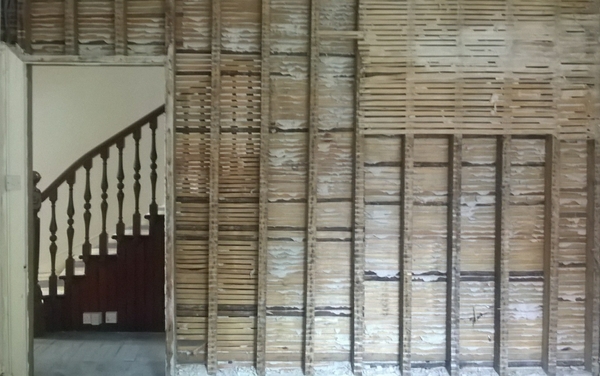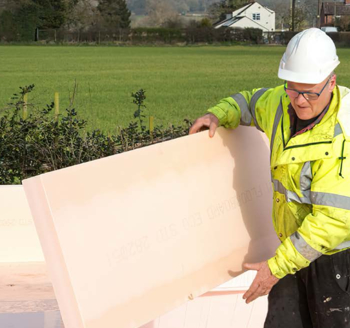Renovation
Contents |
[edit] Introduction
The term ‘renovation’ refers to the process of returning something to a good state of repair. In the construction industry, renovation refers to the process of improving or modernising an old, damaged or defective building. This is as opposed to 'retrofitting' which is providing something with a component or feature not originally fitted, or 'refurbishment' which is a process of improvement by cleaning, decorating, or re-equipping.
According to Approved document L of the building regulations, 'major renovation' means '...the renovation of a building where more than 25% of the surface area of the building envelope undergoes renovation'.
It is common for people to purchase run-down properties, often houses, and renovating them as a means of increasing their value. Typically, renovation work is categorised as ‘cosmetic’ or ‘structural’.
Structural renovation might include:
- Extensions.
- Loft conversions.
- Construction of a basement.
- Redesign of floor plans.
- Re-wiring, re-plumbing, new drainage lines and so on.
Cosmetic renovation might include:
- Painting and other forms of decoration and minor repairs.
- Flooring.
- Updating fixtures and fittings.
- Light landscaping
[edit] Renovation process
Carefully preparing for renovation before starting is crucial terms of estimating the likely cost and programme and ultimately delivering a successful, problem-free project.
[edit] Finding a project
Online search engines are the easiest way of finding suitable properties, although it should be borne in mind that agents may not be aware of the true potential of some properties.
Properties may also be found by word of mouth, or simply by keeping your eyes open when passing buildings.
Very often, renovation projects are sold at auction, go to sealed bids, or are settled on best or final offers. Understanding these processes is integral to becoming the successful bidder.
For more information, see Bidding for renovation works.
[edit] Financing
If the renovation is to be more cosmetic, high street lenders may be the best option in terms of acquiring a loan. If more structural work is required, i.e. to make the property habitable, then financing may require a specialist lender. There are several lenders that offer renovation-specific mortgages with only small cash deposits required. They are often stage payment mortgages meaning that funds are released at various milestones during the project delivery.
Grants may also be available for renovation works, either at a local level from local authorities or at the national level from central government bodies.
In additional to the work itself, there are other costs associated with renovation projects, including:
- Searches.
- Surveys and valuation fees.
- Property acquisition costs (including stamp duty land tax).
- Finance costs.
- Legal costs.
- Travel costs.
- Security and storage.
- Reconnection to utilities.
- Professional fees such as project managers, structural engineers, architects, and so on.
- Building regulations approval.
- Planning permission.
- Furniture, fittings and equipment.
- Contingency fund in case of unexpected circumstances.
[edit] Condition assessment
It is important to get a detailed assessment of the condition of the building. A chartered surveyor can be commissioned to provide a building report identifying essential repairs or further investigation that is needed. This will also help identify the type of construction used throughout the structure which can provide a steer in terms of appropriate redesign and construction techniques.
It is generally beneficial to attend the survey, as it is then possible to ask questions or to draw the attention of the surveyor to specific issues.
A measured survey, and the preparation of scale drawings may be required if the building is to be remodelled or extended.
[edit] Secure the building
A building will start deteriorating if it is left empty for more than a few months. This can rapidly accelerate if damp gets inside due to broken windows, slipped tiles, and so on. An empty property may also be susceptible to vandalism, trespassing and theft.
It is important therefore that a property is secured and made weathertight before work begins. Metal shutters can be rented, or sheets of plywood used to board up windows and doors. Waterproof sheets can be used to secure missing or damaged roof sections.
Buildings and public liability insurance cover may be required to protect against damage, fire, construction works, and so on.
[edit] Consents
While some aspects of the project, such as a garage or loft conversion may fall within the allowances made under Permitted Development Rights, it is necessary to consider which aspects of the proposed renovation might require planning permission. In addition, building regulations approval may be required for anything other than minor cosmetic works. Other permissions may also be required, such as listed building consent, conservation area consent, landlord approval, party wall act agreement, and so on.
A solicitor can help check the title deeds or lease for any other development restrictions that may apply.
The earlier that applications are submitted the better, as they can take several months to be processed.
[edit] Initial construction works
The initial works might include:
- Securing the site.
- Identifying areas for materials and plant storage.
- Identifying available options if the site has restricted access.
- Checking existing drains and other service connections.
- Ensuring there is a water and electricity supply.
- Identifying any work required to stabilise the structure, such as underpinning, piling or foundation stabilisation.
- Making the building weather-tight.
- Demolition work required to strip the structure back as required.
- Identifying and solving any problems with damp. For more information, see Damp in buildings.
- Treatment of any infestations.
[edit] Structural work and extensions
Structural work can begin once the existing building is stable. All structural work must comply with the Building Regulations. It is important to ensure the existing building is protected from damage during the works using plastic sheets, boards, and so on.
[edit] First fix
When the structural works are nearing completion, work can begin on internal stud walls, flooring, fixing ceiling joists, new staircases, wiring and plumbing works, and so on.
Things that may later be concealed by plaster will need to be installed at this stage, such as:
- Ventilation and extract ducts.
- Wiring for power, lighting, central heating controls, alarms, aerials, speakers, phone and data, and so on.
- Plumbing for water supply, heating, drainage, and so on.
Following this, re-plastering can be carried out, along with new flooring or other surfaces that are required.
[edit] Second fix
This includes:
- Fitting light fittings, sockets, switches, phones, TV points, and so on.
- Hanging doors.
- Fixing skirting, architraves, spindles and handrails.
- Installing bathroom fittings.
- Installing boiler and controls, and fitting radiators.
- Fitting kitchens and any fitted furniture.
- Preparing surfaces for decorating.
[edit] Decorating
Painting, staining, varnishing and so on begins once second fix work and preparation is complete. To achieve a good finish it is important that the surfaces are thoroughly smooth and clean in advance. Tiling of bathrooms and kitchens should also be done at this stage, as well as any soft floor coverings such as vinyl and carpet.
[edit] Snagging
Small problems will often arise after the renovation is complete. A retention sum may be retained until tradesmen or contractors have resolved any defects which are their responsibility.
[edit] Common pitfalls of renovation
Renovation projects can face a number of common pitfalls.
[edit] Wrong property
The aim when looking for a property to renovate is to find one that isn’t in a condition that will require very serious work, or even rebuilding. It can be wise to commission a survey before making a bid, as this can highlight defects and structural issues that could make the investment more risky than expected. If it is an old building, it is important to check whether it is listed, or in a conservation area as this can limit the changes that can be made.
It can also be wasteful to purchase a property that is already in reasonable condition, as renovation works may involve removing items that still have life left in them, whilst only marginally increasing the value of the property at significant cost.
[edit] Poor cost control
It is prudent to keep a contingency sum of 10-20% of the remaining spend in case of emergencies (not just as a general 'slush fund').
In older properties it can be better to ‘make do and mend’ rather than spending on costly replacements.
In order to keep costs down and avoid misunderstandings over details, good communication between client and builder is vital.
Often people can make the mistake of ordering too few materials in the process of trying to keep costs down. Ordering extra materials can incur time delays and additional costs.
[edit] Incorrect budgets
Budgets are often over optimistic, as developers are keen to get on with the work. This can prove risky, as renovation is generally less predictable than new build, with many ‘hidden costs’ not being accounted for in the original budget.
Generally costs go up, whilst actual returns do not match expectations.
[edit] Focus on unnecessary work
Renovators can sometimes focus on the more cosmetic aspects of the project, whilst neglecting the more important structural issues that could end up being very costly.
In period properties it is sensible to adopt a ‘repair not replace’ approach, as retaining period features is often cheaper than replacing them, and they can add character to the property.
[edit] Incorrect materials
Problems can arise when buildings are renovated using incorrect or the cheap materials.
So-called ‘miracle treatments’ can also be a problem when applied to older buildings. For example, spray-on renders and polyurethane foams can obstruct crucial ventilation paths in walls and roofs.
[edit] Spending over the ‘market ceiling’
There is a ‘market ceiling’ that applies to every location which dictates the maximum amount buyers are prepared to spend, regardless of the special features that can be added to a renovation project. It is important not to get carried away and fit features that exceed those expectations. Conversely, it is important not to spend money on misguided works that actually reduce the value of the property.
[edit] Renovation in relation to a thermal element
According to approved document L, renovation in relation to a thermal element means:
| the provision of a new layer in the thermal element (other than where that new layer is provided solely as a means of repair to a flat roof) or the replacement of an existing layer, but excludes decorative finishes, and 'renovate' shall be construed accordingly. |
[edit] Related articles on Designing Buildings
- Alterations to existing buildings.
- Façade retention.
- Licence to alter.
- Loft conversion.
- Refurbishment.
- Rehabilitation.
- Remedial works.
- Renovate, operate, transfer (ROT).
- Renovation v refurbishment v retrofit.
- Restoration.
- Retrofit.
- Tips for house renovations on a budget.
- Upcycling buildings.
- Upgrade.
Featured articles and news
Building Safety Regulator reforms
New roles, new staff and a new fast track service pave the way for a single construction regulator.
Cooling centres and cool spaces
Managing extreme heat in cities by directing the public to places for heat stress relief and water sources.
Winter gardens: A brief history and warm variations
Extending the season with glass in different forms and terms.
Restoring Great Yarmouth's Winter Gardens
Transforming one of the least sustainable constructions imaginable.
Construction Skills Mission Board launch sector drive
Newly formed government and industry collaboration set strategy for recruiting an additional 100,000 construction workers a year.
New Architects Code comes into effect in September 2025
ARB Architects Code of Conduct and Practice available with ongoing consultation regarding guidance.
Welsh Skills Body (Medr) launches ambitious plan
The new skills body brings together funding and regulation of tertiary education and research for the devolved nation.
Paul Gandy FCIOB announced as next CIOB President
Former Tilbury Douglas CEO takes helm.
UK Infrastructure: A 10 Year Strategy. In brief with reactions
With the National Infrastructure and Service Transformation Authority (NISTA).
Ebenezer Howard: inventor of the garden city. Book review.
The Grenfell Tower fire, eight years on
A time to pause and reflect as Dubai tower block fire reported just before anniversary.
Airtightness Topic Guide BSRIA TG 27/2025
Explaining the basics of airtightness, what it is, why it's important, when it's required and how it's carried out.
Construction contract awards hit lowest point of 2025
Plummeting for second consecutive month, intensifying concerns for housing and infrastructure goals.
Understanding Mental Health in the Built Environment 2025
Examining the state of mental health in construction, shedding light on levels of stress, anxiety and depression.
The benefits of engaging with insulation manufacturers
When considering ground floor constructions.
Lighting Industry endorses Blueprint for Electrification
The Lighting Industry Association fully supports the ECA Blueprint as a timely, urgent call to action.























Comments
Renovation refers to the process of making improvements, modifications, or updates to an existing building, space, or structure. Renovations can range from minor cosmetic changes to extensive overhauls that involve significant alterations to the layout, functionality, and design of a space. Here's a general overview of the renovation process:
1. **Assessment and Planning**:
- Identify the goals and objectives of the renovation. Determine what changes you want to make and why.
- Evaluate the current condition of the space. Identify any structural, mechanical, or aesthetic issues that need to be addressed.
- Plan the scope of the renovation, including the extent of changes, budget, timeline, and required permits.
2. **Design and Concept Development**:
- Work with architects, interior designers, or design professionals to develop a renovation plan that aligns with your goals and vision.
- Create detailed drawings, sketches, or digital models to visualize the proposed changes.
- Choose materials, colors, finishes, and other design elements that suit your preferences and the functionality of the space.
3. **Obtain Necessary Approvals**:
- Depending on the scope of the renovation, you might need to obtain permits and approvals from local building authorities. This is particularly important for structural changes or changes that affect building codes and regulations.
4. **Preparation and Demolition**:
- Clear out the space by removing furniture, fixtures, and any items that could be damaged during construction.
- If needed, carry out demolition work to remove walls, flooring, and other elements that will be replaced or modified.
5. **Structural Work and Repairs**:
- Address any structural issues, such as repairing damaged walls, floors, or foundations.
- Make changes to the layout, such as adding or removing walls, doorways, or windows.
6. **Mechanical and Electrical Systems**:
- Upgrade or modify plumbing, electrical, heating, ventilation, and air conditioning systems as necessary.
- Ensure that all systems comply with safety standards and regulations.
7. **Interior Finishes**:
- Install new flooring, wall finishes, ceilings, and other interior elements.
- Paint or apply finishes to walls and ceilings as per the design plan.
8. **Cabinetry and Fixtures**:
- Install new cabinetry, countertops, sinks, faucets, and other fixtures in kitchens, bathrooms, and other relevant areas.
9. **Lighting and Electrical**:
- Install new lighting fixtures, switches, and outlets according to the design plan.
10. **Final Touches**:
- Install decorative elements, such as trim, molding, and decorative hardware.
- Furnish the renovated space with furniture, decor, and accessories.
11. **Inspection and Approval**:
- Schedule inspections as required by local building authorities to ensure that the renovations meet safety and code standards.
12. **Completion and Cleanup**:
- Ensure that all work is completed to your satisfaction and that any remaining construction debris is removed.
- Conduct a final walkthrough to ensure that everything is in place and functioning properly.
Renovations can vary widely in complexity and scope, so it's important to plan carefully, budget realistically, and work with qualified professionals to achieve the desired results.